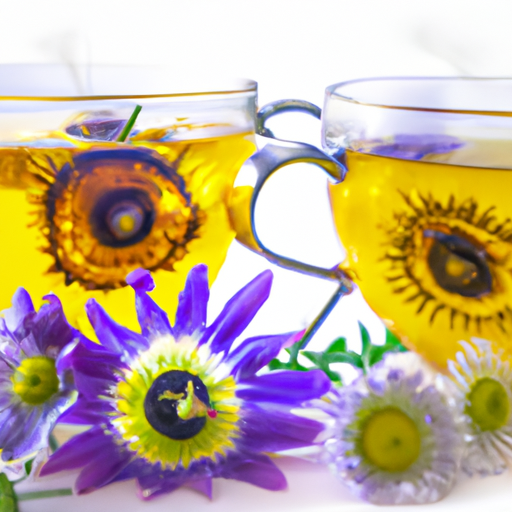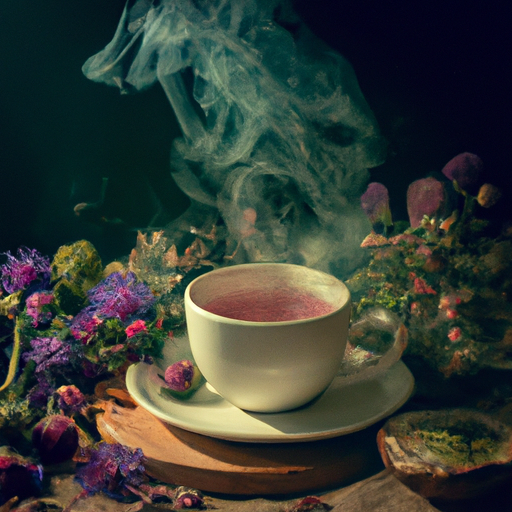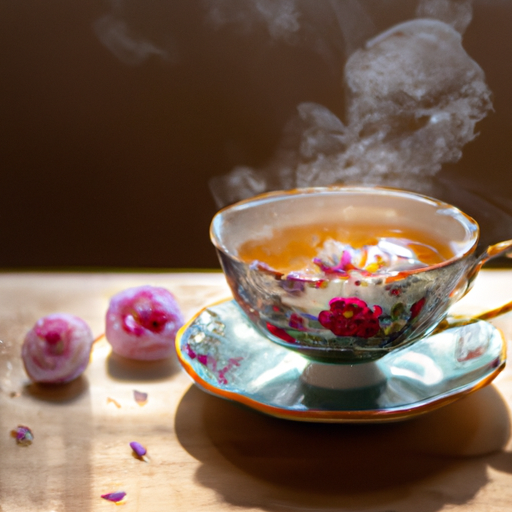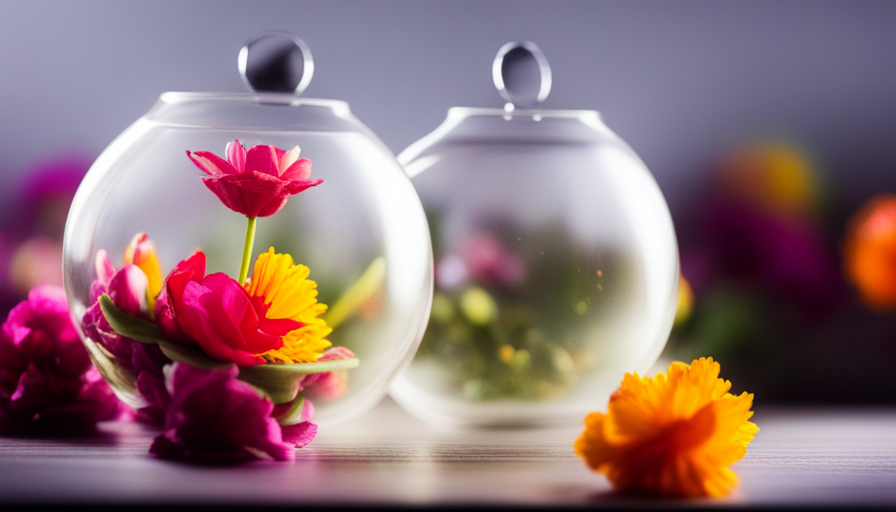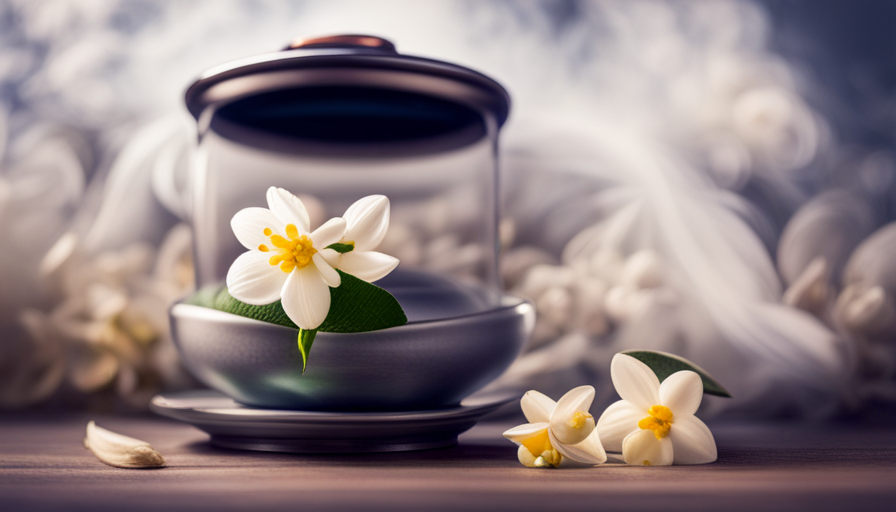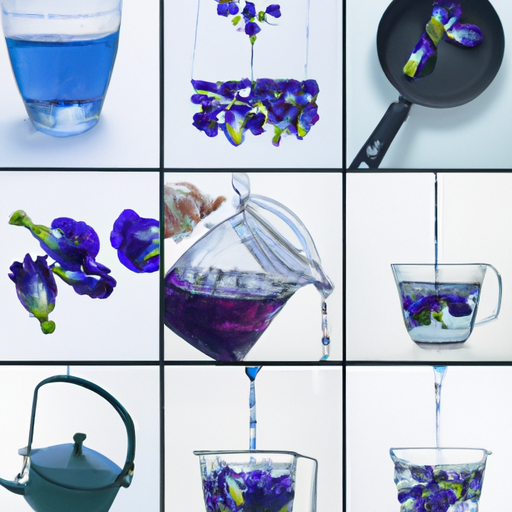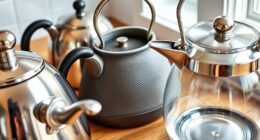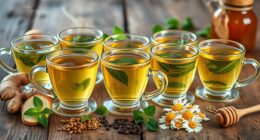I know what you’re thinking – with so many herbal teas out there, how do you know which one is the best for you?
Well, when it comes to choosing between passion flower tea and chamomile tea, the decision can be tough. Both of these teas have gained popularity for their calming and soothing effects, making them great options for relaxation and stress relief.
But what works better? In this article, we will explore the benefits and efficacy of passion flower tea and chamomile tea, based on evidence and expert opinions. We will compare their active ingredients, examine research studies on their efficacy, and consider important factors to consider when choosing the right tea for you.
So, if you’re ready to find out which tea reigns supreme, read on!
Key Takeaways
- Passion flower tea is effective for sleep disorders and insomnia, while chamomile tea is recommended for sleep issues and relaxation.
- Passion flower tea has a floral and fruity taste, while chamomile tea has a mild and earthy taste.
- Passion flower tea reduces anxiety and improves sleep quality due to its sedative effect, while chamomile tea helps with anxiety and sleep through its anti-inflammatory and antioxidant effects.
- Personal preferences play a significant role in choosing between the two teas.
Overview of Passion Flower Tea
If you’re looking for a natural way to relax and unwind, passion flower tea is your go-to drink, guaranteed to soothe your soul and transport you to a state of blissful tranquility. This herbal infusion is made from the flowers of the Passiflora incarnata plant, which is native to North America.
Passion flower tea has a unique chemical composition that contributes to its potential health benefits. It contains flavonoids, such as apigenin and chrysin, which have been shown to possess anti-anxiety and sedative properties. These compounds interact with certain receptors in the brain, promoting a calming effect and reducing feelings of stress and anxiety. Passion flower tea has also been found to have antioxidant and anti-inflammatory effects, which can support overall health and well-being.
In addition to its potential health benefits, passion flower tea is also known for its pleasant taste and aroma. It has a delicate floral flavor with hints of citrus and a slightly sweet undertone. Many people find the act of sipping on a warm cup of passion flower tea to be a soothing and comforting experience.
Transitioning to the overview of chamomile tea, another popular herbal tea known for its relaxation properties, let’s explore how it compares to passion flower tea in terms of effectiveness and benefits.
Overview of Chamomile Tea
Chamomile tea has a rich history and origins dating back to ancient Egypt, where it was used for its medicinal properties. It’s derived from the chamomile flower, which is known for its calming and soothing effects.
Research has shown that chamomile tea can effectively reduce anxiety and promote relaxation, making it a popular choice for those seeking a natural remedy for stress relief.
Origins and history of chamomile tea
You’ll be fascinated to learn that chamomile tea has been enjoyed for centuries, with its origins dating back to ancient Egypt and Rome. The Egyptians revered chamomile for its healing properties and used it to treat various ailments. The Romans also valued chamomile for its calming effects and often drank it as a beverage before bed to promote relaxation.
Chamomile tea is made from the flowers of the chamomile plant, scientifically known as Matricaria chamomilla. It is known for its gentle, floral aroma and delicate flavor. Besides its rich history, chamomile tea is also renowned for its health benefits. It is believed to have anti-inflammatory, antioxidant, and antimicrobial properties. Additionally, chamomile tea is often used to promote sleep, reduce anxiety, and soothe digestive issues.
Moving on to the benefits and effects of chamomile tea on relaxation and anxiety reduction…
Benefits and effects of chamomile tea on relaxation and anxiety reduction
Experience the soothing and calming effects of this ancient herbal remedy as chamomile tea gently eases your mind and melts away anxiety. Chamomile tea has been used for centuries to promote relaxation and reduce anxiety, and scientific research supports its effectiveness.
Here are three ways chamomile tea can benefit your wellbeing:
-
Impact on sleep quality: Chamomile tea has been shown to improve sleep quality by reducing insomnia and promoting deep, restful sleep. Its calming properties help relax the mind and body, allowing for a more peaceful night’s rest.
-
Comparison to lavender tea for anxiety reduction: While both chamomile and lavender tea have anxiety-reducing effects, chamomile tea has been found to be more effective in reducing symptoms of generalized anxiety disorder. Its natural compounds, such as apigenin, bind to specific receptors in the brain, producing an anxiolytic effect.
-
Holistic approach to anxiety relief: Chamomile tea not only reduces anxiety but also alleviates associated symptoms such as irritability and restlessness. It provides a holistic approach to anxiety relief, addressing both the physical and emotional aspects of stress.
As we delve deeper into the comparison of active ingredients, we can explore the unique properties of chamomile tea and its potential advantages over other herbal remedies.
Comparison of Active Ingredients
When comparing the chemical compounds found in passion flower tea and chamomile tea, it’s important to consider their individual properties and potential effects.
Passion flower tea contains flavonoids, such as apigenin and quercetin. These flavonoids have been shown to possess anti-anxiety and sedative properties.
On the other hand, chamomile tea contains chamazulene and bisabolol. These compounds exhibit anti-inflammatory and antioxidant effects.
Both teas offer unique chemical profiles that contribute to their respective therapeutic benefits.
Chemical compounds found in passion flower tea
Chemical compounds found in passion flower tea, such as flavonoids and alkaloids, contribute to its potential therapeutic effects. Here’s an overview of the effectiveness of passion flower tea, based on the compounds found in it:
-
Flavonoids: Passion flower tea contains various flavonoids, including apigenin and quercetin. These compounds have antioxidant properties and may help reduce inflammation in the body.
-
Alkaloids: Passion flower tea contains alkaloids like harmine and harmane. These compounds have been found to have sedative and anxiolytic effects, which can help promote relaxation and reduce anxiety.
-
Chrysin: Another compound found in passion flower tea is chrysin, which has shown potential in reducing symptoms of anxiety and improving sleep quality.
-
Vitamins and minerals: Passion flower tea is also a good source of vitamins and minerals like vitamin C, magnesium, and potassium, which contribute to its overall health benefits.
Now, let’s explore the chemical compounds found in chamomile tea.
Chemical compounds found in chamomile tea
Chamomile tea, with its unique blend of compounds, offers a soothing and calming effect that can help promote relaxation and improve sleep quality. Compared to other herbal teas, chamomile stands out for its potential health benefits.
It contains several bioactive compounds, including chamazulene, apigenin, and bisabolol, which possess anti-inflammatory and antioxidant properties. These compounds may contribute to chamomile’s ability to reduce anxiety, alleviate digestive issues, and enhance skin health.
Research studies have suggested that chamomile tea can also help with managing menstrual pain and reducing symptoms of depression. Furthermore, chamomile tea is caffeine-free, making it a suitable choice for those looking for a natural way to unwind without the stimulating effects of caffeine.
Transitioning into the subsequent section about research studies on the efficacy of passion flower tea, it is worth exploring how these two herbal teas compare in terms of their potential benefits.
Research Studies on the Efficacy of Passion Flower Tea
If you want to maximize the benefits of tea, passion flower tea has been shown to be effective in several research studies. It’s been found to be particularly helpful in treating insomnia and anxiety. Here are some important findings from these studies:
-
Passion flower tea has been shown to improve sleep quality and reduce the time it takes to fall asleep.
-
It has been found to be as effective as some prescription sleep medications, but without the side effects.
-
Passion flower tea has been compared to other herbal remedies for anxiety, such as kava and valerian, and has been found to be just as effective, if not more so.
-
It can help reduce symptoms of anxiety, such as restlessness and nervousness.
-
Passion flower tea has also been shown to have a calming effect on the nervous system, making it a great option for those who struggle with stress and tension.
These research studies provide strong evidence for the efficacy of passion flower tea in promoting sleep and reducing anxiety. However, it’s important to note that everyone’s body may respond differently to herbal remedies.
Now, let’s delve into the research studies on the efficacy of chamomile tea.
Research Studies on the Efficacy of Chamomile Tea
In my research on the efficacy of chamomile tea, I discovered several findings on its effects on relaxation and anxiety reduction.
Numerous studies have shown that chamomile tea has a calming effect on the body, promoting relaxation and aiding in the reduction of anxiety symptoms.
Additionally, chamomile tea has been found to have potential side effects and interactions, such as allergic reactions or interactions with certain medications, that should be taken into consideration before consuming it regularly.
Findings on the effects of chamomile tea on relaxation and anxiety reduction
Indulge in a cup of chamomile tea and let your worries melt away like a gentle breeze on a summer evening. When it comes to relaxation and anxiety reduction, chamomile tea has shown promising results in research studies.
Comparing the effectiveness of chamomile tea to lavender tea, chamomile has been found to be just as effective, if not more so, in promoting relaxation and reducing anxiety.
Additionally, chamomile tea has potential benefits in improving sleep quality and reducing insomnia. Its calming properties can help to ease the mind and encourage a restful night’s sleep.
However, it’s important to note that chamomile tea may have potential side effects or interactions, which will be discussed in the next section.
So, while chamomile tea can be a natural and effective way to relax and reduce anxiety, it’s essential to be aware of any potential risks.
Potential side effects or interactions of chamomile tea
Sip on a cup of this herbal infusion and discover the potential side effects or interactions that may arise from enjoying chamomile tea. It’s important to be aware of the potential risks and adverse reactions associated with chamomile tea, especially if you have any pre-existing health conditions or you’re taking medications.
Here’s a nested bullet point list in markdown format to give you a clear picture:
-
Allergic reactions: Some individuals may experience allergic reactions to chamomile tea, such as skin rashes, itching, or swelling.
-
Caution: If you have a history of allergies, it’s recommended to consult with a healthcare professional before consuming chamomile tea.
-
Interactions with medications: Chamomile tea may interact with certain medications, such as blood thinners, sedatives, or anti-anxiety drugs.
-
Caution: If you’re taking any medications, it’s advisable to seek medical advice before incorporating chamomile tea into your routine.
It’s crucial to be well-informed about the potential side effects or interactions of chamomile tea. Now, let’s delve into personal experiences and testimonials to gain a deeper understanding.
Personal Experiences and Testimonials
Experience the soothing embrace of passion flower tea as it gently lulls you into a state of tranquility, allowing your worries to melt away like a warm summer breeze. Passion flower tea has been praised for its effectiveness in treating sleep disorders, providing a natural remedy for those struggling with insomnia or restless nights.
Many individuals have found that passion flower tea promotes a deeper and more restful sleep, leaving them feeling refreshed and rejuvenated in the morning.
When it comes to taste and aroma, passion flower tea offers a unique and pleasant experience. Its delicate floral notes and subtle sweetness create a soothing and enjoyable drinking experience. Comparing it to chamomile tea, passion flower tea provides a more complex flavor profile that’s often described as earthy and slightly fruity.
The aroma of passion flower tea is also distinct, with a calming and inviting scent that adds to the overall relaxation it provides.
As I continue to explore the benefits of passion flower tea, it’s important to consider expert opinions and recommendations. These insights will provide a comprehensive understanding of the tea’s potential and guide us towards making informed decisions about its usage.
Expert Opinions and Recommendations
In my experience as a herbalist, I’ve found that passion flower tea can be incredibly beneficial for promoting relaxation and reducing anxiety. Many herbalists and naturopaths also recommend passion flower tea for its calming properties and its ability to improve sleep quality.
On the other hand, chamomile tea is often praised by herbalists and naturopaths for its soothing effects on the digestive system and its ability to alleviate symptoms of indigestion and bloating. Additionally, chamomile tea is known for its anti-inflammatory properties and can be a great option for those seeking relief from menstrual cramps or other inflammatory conditions.
Insights from herbalists or naturopaths on passion flower tea
According to herbalists and naturopaths, passion flower tea has been praised for its calming properties and is often recommended as a natural remedy for anxiety and insomnia. Here are some insights from naturopaths on the benefits and effects of passion flower tea on sleep:
-
Improved Sleep Quality: Passion flower tea is believed to promote better sleep by reducing anxiety and calming the mind, allowing for a more restful and rejuvenating sleep.
-
Reduced Insomnia Symptoms: Passion flower tea has been shown to help alleviate symptoms of insomnia, such as difficulty falling asleep or staying asleep throughout the night.
-
Relaxation and Stress Relief: The natural compounds found in passion flower tea have been found to have a sedative effect, promoting relaxation and reducing stress levels.
These findings highlight the potential positive impact of passion flower tea on sleep. Transitioning to the subsequent section, let’s explore the insights from herbalists or naturopaths on chamomile tea.
Insights from herbalists or naturopaths on chamomile tea
As we discussed in the previous section, herbalists and naturopaths have shared valuable insights on the benefits of passion flower tea. Now, let’s turn our attention to chamomile tea and explore what these experts have to say about it.
According to herbalists, chamomile tea has long been used as a natural remedy for sleep issues and relaxation. The calming properties of chamomile are believed to help reduce anxiety and promote a restful night’s sleep. It’s often recommended as a gentle and safe option for those struggling with insomnia or restless sleep.
Additionally, chamomile tea is known for its anti-inflammatory and digestive benefits. These insights from herbalists highlight the potential benefits of chamomile tea on sleep and overall well-being.
Now, let’s delve into the factors to consider in choosing the right tea for your needs.
Factors to Consider in Choosing the Right Tea
When it comes to choosing the right tea, there are a few key factors that I always consider.
First and foremost, individual preferences and tastes play a crucial role. Some people may prefer the floral and soothing taste of chamomile tea, while others may find the earthy and calming flavor of passion flower tea more appealing.
Additionally, the availability and affordability of the teas are important factors to consider, as it can impact how easily accessible and sustainable the tea is for regular consumption.
Individual preferences and tastes
While sipping on a warm cup of passion flower tea or chamomile tea, one can savor the unique flavors and choose their favorite based on personal preference. When it comes to personal preferences, it’s important to consider factors such as taste, aroma, and overall experience. Both passion flower tea and chamomile tea offer distinct flavors that appeal to different palates. To help you make an informed decision, I have created a table comparing the taste profiles of these two herbal teas:
| Tea | Taste | Aroma |
|---|---|---|
| Passion Flower | Floral and fruity | Sweet and calming |
| Chamomile | Mild and earthy | Apple-like |
Considering the health benefits of herbal teas, both passion flower and chamomile have been used for centuries to promote relaxation and relieve stress. However, passion flower tea is also known for its potential to improve sleep quality, while chamomile tea is often praised for its anti-inflammatory properties. With these insights in mind, one can choose their preferred tea based on both personal taste and desired health benefits. Moving forward, it’s important to consider the availability and affordability of these teas in order to make the best choice for oneself.
Availability and affordability of the teas
For tea enthusiasts, it’s always exciting to explore the market and discover the wide range of options available for both taste and budget.
When comparing passion flower tea and chamomile tea, availability and affordability play a crucial role. Passion flower tea can be found in health food stores and online retailers, making it easily accessible. On the other hand, chamomile tea is widely available in grocery stores and supermarkets.
In terms of cost, passion flower tea tends to be slightly more expensive than chamomile tea. However, when it comes to effectiveness and quality, both teas have their unique benefits. Passion flower tea is known for its calming properties, while chamomile tea is often used for promoting relaxation and aiding sleep.
Ultimately, the choice between the two teas depends on personal preferences and needs. Transitioning into the conclusion and final thoughts, it is important to consider all factors before making a decision.
Conclusion and Final Thoughts
In conclusion, it’s worth considering the potential benefits and effects of both passion flower tea and chamomile tea before deciding which one may work better for you.
While both teas have been used for centuries as natural remedies for stress, anxiety, and sleep issues, the effectiveness of each may vary depending on personal preferences and individual needs.
Passion flower tea is known for its calming properties and has been found to reduce anxiety and improve sleep quality. It contains flavonoids that have a sedative effect on the central nervous system, promoting relaxation and reducing insomnia.
On the other hand, chamomile tea has been shown to have anti-inflammatory and antioxidant effects, which may help with reducing anxiety and promoting better sleep.
When it comes to choosing between passion flower tea and chamomile tea, personal preferences play a significant role. Some people may find the taste and aroma of passion flower tea more appealing, while others may prefer the mild and soothing taste of chamomile tea.
Both passion flower tea and chamomile tea have their own unique benefits and effects. It’s important to consider your personal preferences and individual needs when deciding which tea may work better for you. Further research and consultation with a healthcare professional can provide additional guidance in making the best choice for your specific situation.
To explore additional resources and further reading on herbal teas, continue to the next section.
Additional Resources and Further Reading
If you’re interested in learning more about herbal teas and their potential benefits, there are additional resources and further reading available for you to explore. Here are four recommended sources to delve deeper into the world of herbal teas:
-
‘Herbal Teas: 101 Nourishing Blends for Daily Health & Vitality’ by Kathleen Brown: This book provides a comprehensive guide to various herbal teas and their health benefits. It includes recipes and tips on how to incorporate herbal teas into your daily routine.
-
‘The Green Pharmacy Herbal Handbook’ by James A. Duke: This authoritative resource offers a wealth of information on medicinal herbs, including their uses, safety, and potential interactions. It covers a wide range of herbs, including passion flower and chamomile.
-
National Center for Complementary and Integrative Health (NCCIH) website: The NCCIH provides evidence-based information on herbal and alternative medicine. Their website offers research-backed articles and resources on herbal teas and their potential health benefits.
-
PubMed: As a trusted database for scientific research, PubMed is an excellent resource for further research on herbal teas. It features a vast collection of studies and articles exploring the potential health benefits and risks associated with herbal teas.
It’s important to note that while herbal teas like passion flower and chamomile are generally safe, they may still pose potential health risks for certain individuals. Further research is needed to fully understand their effects and interactions with medications. It’s always wise to consult with a healthcare professional before incorporating any herbal teas into your routine.
Frequently Asked Questions
Are there any side effects or potential risks associated with drinking passion flower tea or chamomile tea?
I’ve found that both passion flower tea and chamomile tea are generally safe for most people to consume. However, it’s important to note that there can be potential risks associated with drinking these teas.
For example, some individuals may experience allergic reactions to either tea. Additionally, both passion flower tea and chamomile tea can interact with certain medications or medical conditions, so it’s always advisable to consult with a healthcare professional before consuming these teas regularly.
Can passion flower tea or chamomile tea interact with any medications or medical conditions?
Passion flower tea and chamomile tea have the potential to interact with certain medications and medical conditions. It’s important to consult with a healthcare professional before consuming these teas if you’re taking any medications, especially sedatives or blood thinners. Both teas may enhance the effects of these medications and increase the risk of side effects.
Additionally, if you have any medical conditions like low blood pressure or liver disease, it’s advisable to exercise caution and seek medical advice before consuming these teas.
How long does it typically take for passion flower tea or chamomile tea to start showing its effects?
Passion flower tea and chamomile tea both have their own unique effects and brewing times. To brew passion flower tea, it typically takes around 10-15 minutes. Once consumed, passion flower tea may start showing its effects within 30 minutes.
On the other hand, chamomile tea usually takes around 5-10 minutes to brew and its effects may be felt within 10-15 minutes of consumption.
Both teas have been found to promote relaxation, calmness, and improved sleep quality.
Are there any specific dosage recommendations for passion flower tea or chamomile tea?
When it comes to dosage recommendations for passion flower tea or chamomile tea, it’s important to note that there’s no one-size-fits-all approach. The appropriate dosage can vary depending on factors such as age, overall health, and the reason for taking the tea. It’s always best to consult with a healthcare professional or an herbalist who can provide personalized guidance. Additionally, while both teas have been shown to have calming effects, the effectiveness comparison between passion flower tea and chamomile tea may vary from person to person.
Can passion flower tea or chamomile tea be used in combination with other herbal teas or natural remedies for enhanced benefits?
Passion flower tea and chamomile tea offer numerous benefits on their own, but they can also be combined with other herbal remedies for enhanced effects. Passion flower tea is known for its calming properties and can be combined with herbs like lavender or lemon balm for further relaxation.
Chamomile tea has anti-inflammatory and digestive benefits and pairs well with herbs like peppermint or ginger for added relief.
Combining these teas with other herbal remedies can provide a holistic approach to wellness.
Conclusion
In conclusion, after exploring the benefits and research studies of both passion flower tea and chamomile tea, it’s clear that both teas offer unique advantages. However, when it comes to promoting relaxation and reducing anxiety, chamomile tea stands out as a symbol of tranquility. Its active ingredients, such as apigenin, have been shown to have a calming effect on the body and mind.
While passion flower tea has its own set of benefits, including potential sleep aid properties, chamomile tea remains a popular choice for its soothing and calming effects.

